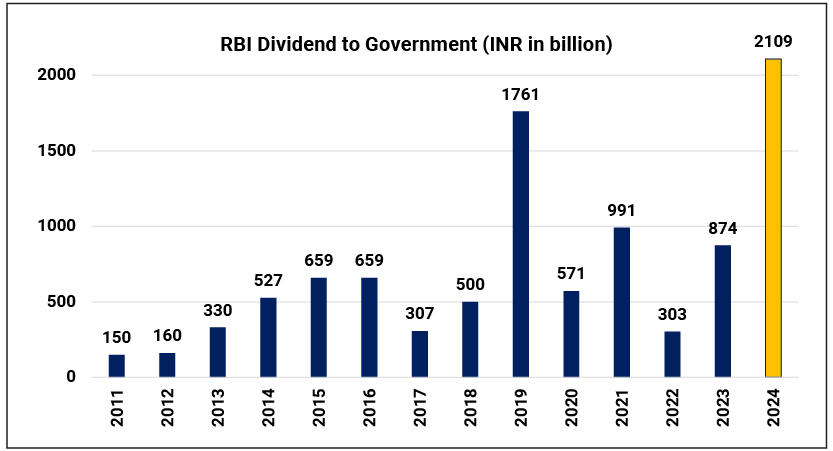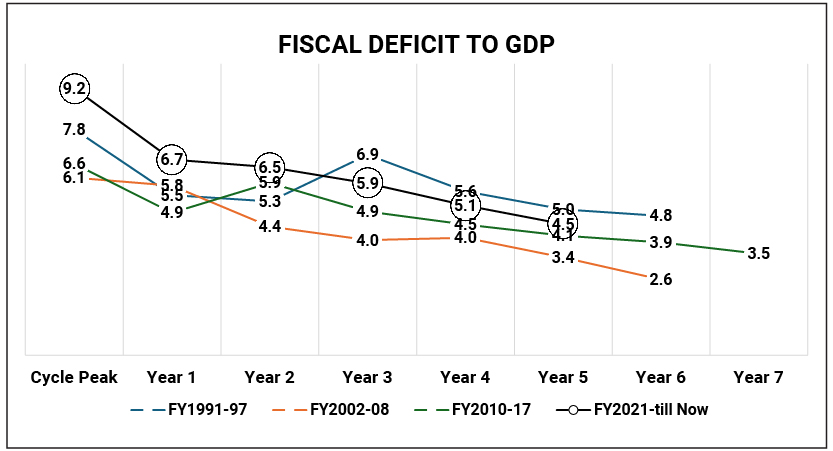Market Mood – Optimism and Resilience
Posted On Friday, Jul 19, 2024
The story of the Indian Fixed Income market so far in 2024, has been about broad based optimism and resilience. There is almost a consensus among investors in expecting the Indian bond market size and depth to grow rapidly with fast expansion in investor base. A similar consensus can also be found about the direction of Indian bond yields which are expected to go down.
Two main pillars of this optimism in the Indian bond market are –
1) India’s inclusion in the global bond indices and growing interest from foreign investors
2) Strong financialization trend domestically leading to rapid growth in domestic institutional investors base such as insurance companies, pension and provident funds.
Furthermore, the confidence in the bond market is also supported by India’s strong macro fundamentals – growing tax base, disciplined fiscal management, strong economic growth, resilient external balances (low current account deficit and balance of payment surplus) and softening inflation trend.
So far in 2024, Indian bond yields have drifted lower with the 10-year Indian government bond (IGB) yield falling from near 7.17% at the start of the year to around 6.97% (as of July 18, 2024). At the same time, 30-year IGB yields have fallen more sharply by 42 basis points from 7.47% to 7.05% exhibiting the growing influence of long-term domestic investors in the bond market and secular improvement in macro fundamentals.
Chart – I: Indian Yields drifting lower; 30yr IGB yield falling faster than other maturities

Source – Bloomberg, Quantum Research; data upto July 18, 2024. Past performance may or may not sustain in future
Indian bonds showed remarkable resilience against increased volatility in the global markets. Although IGB yields continue to take directional cues from US treasuries (UST) on day-to-day basis, it has been quite stable, and range bound amidst high volatility observed in the US treasuries over the last few months. In 2024 so far, 10-year UST yield is up 29 basis points while the 10-year IGB yield is down 20 basis points. This divergence suggests that the relationship between these bond markets has shifted.
Chart – II: Indian Bond yields exhibiting resilience against volatile global markets

Source – Bloomberg, Quantum Research; data upto July 18, 2024. Past performance may or may not sustain in future
Nonetheless, there exists a strong linkage which tends to influence Indian bond yields. When US Treasury yields become more attractive relative to other global fixed-income assets, it can lead to capital outflows from emerging markets like India, potentially affecting Indian bond prices and vice versa.
The market expectations are building around the recent softer-than-expected US inflation reading prompting the Fed to initiate a rate cut cycle starting in September 2024. If this happens, there might be more than one rate cut within this year.
Rate cuts in the US tend to induce risk on trade and capital flows towards emerging markets (EM). With Indian bonds getting into global benchmarks, US rate cuts can meaningfully enhance foreign flows into Indian bonds going forward.
Index Inclusion: Flows moderated but long-term positive
India’s inclusion in JPMorgan’s emerging market debt index was a significant milestone. It marked a pivotal moment for India’s sovereign bond market, akin to the year 1994 when Indian equities debuted on the MSCI Emerging Markets Index, attracting foreign investment to listed enterprises. FPIs now own almost a fifth of India’s $5 trillion equity market, thanks to similar index-driven investments in the past. The inclusion is estimated to bring substantial inflows (estimated at $25-40 bn) into the Indian bond market. (Refer Index Inclusion: How will it unfold).
Chart – III: Foreign buying of Indian bonds picked up momentum post the announcement of Index Inclusion

Source – NSDL, RBI, Data upto June30, 2024
Foreigners have poured in more than USD 10 billion into the Indian government bonds under the fully accessible since the announcement of index inclusion in September 2023. However, the pace of foreign inflows has moderated lately. We would expect foreign flows to pick up again as the Fed starts cutting interest rates by the last quarter of 2024.
RBI’s Push Back:
As most global central banks are preparing to cut interest rates, the RBI continues to push back on the rate cut expectation.
Although two of the six MPC members voted for a rate cut in the last monetary policy review in June highlighting high real rates and slow consumption growth in the economy, the RBI governor along with other MPC members defended their cautious stance with an argument that the growth is holding strong while the headline inflation is still far from the RBI’s 4% goal.
Governor Das in his statement said - “Resilient growth creates space for monetary policy to focus unambiguously on inflation which remains well above the 4.0 per cent target. With persistently high food inflation, it would be in order to continue with the disinflationary policy stance that we have adopted. Any hasty action in a different direction will cause more harm than good.”
The headline CPI inflation has been hovering around 5% for the past few months. As per the recent data release, the headline CPI inflation inched up to 5.08% y-o-y in June against 4.75% in May. However, much of the persistence in the headline CPI is contributed by high food inflation, particularly coming from elevated vegetable and pulses prices. The CPI inflation excluding the impact of vegetable prices, is trending much below the RBI’s 4% target, near 3.5%. While core CPI inflation (ex-Food and Fuel) which is better reflection of the demand conditions in the economy is near 3%.
Chart – IV: Headline CPI Sticky near 5% due to a small subset of food items; Ex-Vegetable CPI continue to trend lower below 3.5%

Source – MOSPI, Quantum Research, Data upto June 2024
Notwithstanding the falling core inflation, the monetary policy might remain dependent on the food inflation outlook going forward. This makes the ongoing monsoon season and sowing trend crucial for monetary policy. So far monsoon has been progressing well (3% below normal upto July 18, 2024) and is forecasted to be above normal for the season. This should bode well for the Kharif food production and ease food prices going forward.
Chart – V: Total rainfall is 3% deficient so far though forecasted to recover

Source: Monsoon Information | India Meteorological Department (imd.gov.in)
Chart – VI: Rainfall pickup in July aiding Kharif acreage

Source: Ministry of Agriculture & Farmers Welfare, Quantum Research, Data as on July 12, 2024
We believe the RBI should have sufficient data on rainfall and sowing by October. We expect the October MPC meeting to be a live one for potential change in the policy direction towards easing. In the interim period, global developments and domestic demand supply will continue to drive the bond markets.
Fiscal overview and Budget expectations:
Following the February Interim Budget, the government received a higher the budgeted dividend from the RBI, and tax revenues are growing faster than anticipated. The RBI transferred a dividend of Rs. 2.1 trillion to the government which is around Rs. 1.3 trillion more than interim budget estimate. We anticipate that the government will allocate part of this surplus for spending and use the remainder to reduce its fiscal deficit.
Chart – VII: RBI’s Dividend Bonanza offers flexibility to spend more without fiscal compromise

Source: RBI, Quantum Research; data upto June 30, 2024
As we noted in the last edition of the Debt Market Observer Balancing Priorities: The Need for Fiscal Reallocation - although overall capital formation and construction activity have been growing at a solid pace, it is proving to be more capital and technology intensive and lesser of a job generator. Also, the sluggish consumption demand is turning out to be a hurdle for a pick-up in private investments.
This presents a case for reallocation of government expenditure to boost demand. We might see increasing allocation towards schemes like housing, rural roads, livelihood promotion etc. in the upcoming budget.
We also see a possibility of reduction in the fiscal deficit to 4.9% of GDP compared to interim budget estimate of 5.1%. Given the one-off nature of the additional revenue, the government might prefer to reduce deficit more aggressively now and get some flexibility for future fiscal management. There is a possibility of a reduction in the government’s borrowing program for FY25 by around Rs. 500-600 billion.
India’s historical fiscal discipline has been lacking, with the FRBM deficit target of 3% of GDP achieved only once in the past 20 years (FY07-08). The NK Singh committee recommended targeting public debt/GDP, aiming for a total public debt limit of 60% of GDP, a goal that has remained elusive. Despite the economy coming out of pandemic challenges, the government has not adhered to these recommendations.
However, the FRBM requirement necessitates a medium-term fiscal roadmap to signal a return to the deficit target of 3%. The upcoming budget might introduce a new fiscal consolidation plan, gradually reducing the fiscal deficit to 3% by FY29 through gradual reduction in FD/GDP.
Medium term fiscal consolidation roadmap will be taken positively for India’s credit rating review by the global rating agencies as indicated in their recent media comments. S&P Global Ratings has recently upgraded India’s sovereign rating outlook to ‘positive’ from ‘stable’. while maintaining the rating at 'BBB' citing - ‘India could receive a sovereign rating upgrade in the next 24 months if the central government manages its finances prudently and reduces the fiscal deficit to 4% of GDP.’
Chart – VIII: History of Fiscal Consolidation in India

Source: CMIE, Quantum Research, Data as of July 2024
What should Investors do?
Bond markets will continue to focus on the fiscal consolidation path and the resultant demand supply balance in the bond market. With a possibility of reduction in fiscal deficit target and the borrowing program, long term bonds yields are poised to fall on positive outcome.
We continue to hold our medium term positive outlook on Indian bonds (refer The Bull Case) supported by a structural shift in demand supply balance, and a cyclical turn in inflation and monetary policy.
India’s inclusion in the global bond indices and rapidly growing domestic financial savings will continue to boost demand in the bond market. At the same time, the government’s fiscal consolidation will continue to reduce supply of bonds making demand supply balance more favorable to the long-term bonds.
Considering a strong case for long term yields to decline over the next 1-2 years backed by the reasons described above, we believe long term government bonds offer a rewarding opportunity.
Dynamic Bond Funds are probably best placed to capture this opportunity with a flexibility to change if things don’t turn out as expected. However, investors need to have a longer holding period of at least 2-3 years to ride through the intermittent volatility.
Investors with shorter investment horizons and low-risk appetites should stick with liquid funds.
Portfolio Positioning
Scheme Name | Investment Approach |
The scheme invests in debt securities of up to 91 days of maturity issued by the government and selected public sector companies. | |
The scheme invests in debt securities issued by the government and selected public sector companies. The scheme follows an active duration management strategy and increases/decreases the portfolio duration (sensitivity to interest rates changes) in accordance with the Interest Rate Outlook. Given our positive view on the bond market, we are maintaining reasonably high duration in the scheme with bulk of portfolio invested in above 10-year maturity segment. |
For any queries directly linked to the insights and data shared in the newsletter, please reach out to the author – Pankaj Pathak, Fund Manager – Fixed Income at [email protected].
For all other queries, please contact Neeraj Kotian – Area Manager, Quantum AMC at [email protected] / [email protected] or call him on Tel: 9833289034
Read our last few Debt Market Observer write-ups -
- Balancing Priorities: The Need for Fiscal Reallocation
- Index Inclusion: How will it Unfold
Name of the Scheme | This product is suitable for investors who are seeking* | Riskometer of Scheme | Riskometer of Tier I Benchmark |
Quantum Liquid Fund An Open-ended Liquid Scheme. A relatively low interest rate risk and relatively low credit risk. |
|  Investors understand that their principal will be at Low Risk |  |
Quantum Dynamic Bond Fund An Open-ended Dynamic Debt Scheme Investing Across Duration. A relatively high interest rate risk and relatively low credit risk. |
|  Investors understand that their principal will be at Moderate Risk |  |
* Investors should consult their financial advisers if in doubt about whether the product is suitable for them.
| Potential Risk Class Matrix – Quantum Liquid Fund | |||
Credit Risk → | Relatively Low | Moderate (Class B) | Relatively High (Class C) |
Interest Rate Risk↓ | |||
| Relatively Low (Class I) | A-I | ||
| Moderate (Class II) | |||
| Relatively High (Class III) | |||
| Potential Risk Class Matrix – Quantum Dynamic Bond Fund | |||
Credit Risk → | Relatively Low | Moderate (Class B) | Relatively High (Class C) |
Interest Rate Risk↓ | |||
Relatively Low (Class I) | |||
| Moderate (Class II) | |||
| Relatively High (Class III) | A-III | ||
Disclaimer, Statutory Details & Risk Factors:The views expressed here in this article / video are for general information and reading purpose only and do not constitute any guidelines and recommendations on any course of action to be followed by the reader. Quantum AMC / Quantum Mutual Fund is not guaranteeing / offering / communicating any indicative yield on investments made in the scheme(s). The views are not meant to serve as a professional guide / investment advice / intended to be an offer or solicitation for the purchase or sale of any financial product or instrument or mutual fund units for the reader. The article has been prepared on the basis of publicly available information, internally developed data and other sources believed to be reliable. Whilst no action has been solicited based upon the information provided herein, due care has been taken to ensure that the facts are accurate and views given are fair and reasonable as on date. Readers of this article should rely on information/data arising out of their own investigations and advised to seek independent professional advice and arrive at an informed decision before making any investments. Mutual fund investments are subject to market risks, read all scheme related documents carefully. |
Related Posts
-

The Pivot
Posted On Friday, Apr 21, 2023
The fiscal year 2022-23 has come to an end. The defining feature
Read More -

Yield Curve Inversion Ahead
Posted On Thursday, Mar 23, 2023
Indian money markets have tightened meaningfully over the last one and a half month.
Read More -

Past, Present, and Future of Inflation
Posted On Friday, Feb 24, 2023
Inflation has been one of the biggest challenges in the post-pandemic world.
Read More




